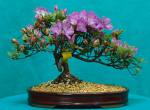SEO Company India
If you are thinking of growing your first bonsai tree and you don't know were to start or what kind of tree to begin with here is some advice to help you make your decision. You can check with a nursery in your area for information about the best species to start with and also advise you on how to grow and care for as well as train your bonsai. It takes time and patience. There are many types of bonsai so do some research and learn about the different types of bonsai trees. There are indoor bonsais and outdoor bonsais. Different bonsai trees have different needs and it is crucial that you know what these needs are conserning the type of tree you want to start with. Some popular bonsai trees and the best trees for bonsai are Juniper, Japanese Red Maple, Pine, Azalea (I love), Chinese Elm, Ficus, and there are more but these are a few.
You can learn through reading books on bonsai and through nurseries and searching through the internet.Click here
You can start your first bonsai tree from seeds but it can take over a year before you can begin pruning. It would be easier to purchase a starter bonsai from a nursery or from an online bonsai site . That way you can start your indoor or outdoor bonsai now. The best starter bonsai to start with is Tropical or subtropical trees. These include Semi-tropical Sea Grape which have large leaves but can be cut down to look good, Japanese Red Maple which are hardy, and Chinese Elm which are sturdy and can adjust to different styles of bonsai.
It is important that you consider the temperature and light when you place your bonsai. The bonsai tree needs morning sun and shade in the heat of the day. Some will take full sun and others won't. It just depends on the type of tree you have.
Other important factors to consider are soil, fertilizer, Pruning.
For soil you want to make sure that you have right type of soil for your bonsai. The pH balance needs differ for different trees.Bonsai Soils
You need to make sure that the bonsai fertilizer is right for your tree.Click here for fertilizer
Now here's the art of bonsai, pruning, prune the branches at the start of spring. Leave the branches you want to keep and make sure you leave enough branches so the tree can live. If the roots are bound to the inside of the pot then cut the roots. It's better to use pruning tools especially for bonsai trees because they are designed specifically for that purpose and it makes pruning easier. Bonsai Tools & Wire



